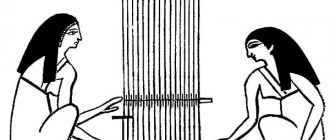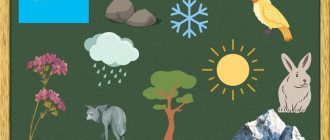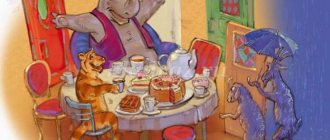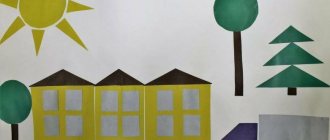Drawing on the topic “Clothes, shoes and hats” in the senior group: understanding the aspects
If in the middle preschool level the children drew clothes, shoes and hats mainly according to a ready-made template, then in the older groups they themselves draw and paint its silhouette. Children 5–6 years old already have a fairly developed sense of shape, color, and proportion. Looking at a piece of clothing, they quickly determine its shape and recreate it on a sheet of paper. In addition, they have no difficulty in drawing things from memory or from an idea.
Children of this age successfully master compositional skills: they place an object on paper according to its proportions: for example, if it is a long sundress or dress, then the sheet of paper is positioned vertically, but if the object is elongated in width (a pair of mittens), then horizontally.
The children's knowledge of basic colors is consolidated, they recognize new colors (purple) and shades (lilac, light green, etc.) and actively use them in their works. Children distinguish between dark and light tones, pale and saturated. Note that the teacher should draw the attention of preschoolers to the fact that not only multi-colored compositions look attractive, but also single-color ones (sometimes this can make the drawing more expressive). However, when drawing clothes, the teacher does not impose his opinion on the children: he gives them the opportunity to express their own preferences.
Drawing clothes, shoes and hats, although it relates to subject matter, is in fact very closely intertwined with decorative drawing: after all, kids not only depict dresses, boots, mittens, but also decorate them with a variety of, sometimes intricate, patterns. The teacher’s task is to help them achieve rhythm in the construction of the ornament.
Materials used and base
When drawing wardrobe items, we mainly use a standard base (A4 sheets of paper). When painting with paints, it is tinted in pale pastel shades. As for ready-made templates, they are offered to children only if the emphasis in the lesson is on decorating clothes with some specific pattern (for example, when depicting the clothes of the ancient Slavs or if the topic is designated “Fabric Painting”). Here, first of all, the decorative skills of preschoolers are assessed. We also note that working with templates is also more appropriate when teaching children with mental retardation.
If group work is expected, the teacher prepares a large template and the required shape in advance.
Preschoolers color the elements to their liking
A blank that several preschoolers will fill in with details
As for drawing tools, in the senior preschool level children are provided not only with colored pencils and paints (gouache and watercolor) - wax crayons and a simple graphite pencil are often used (graphic compositions).
Drawing techniques and techniques to use
In the senior group, all visual skills are further improved. The most key ones are the different positions of the pencil and brush depending on the drawing techniques. When painting large details, the tool leans more towards the paper - the strokes are wider. When drawing small elements, the brush or pencil should be held almost vertically, closer to the base. All these techniques develop ease and freedom of movement, which makes it possible to express creative imagination.
Pupils of the senior group also practice the skill of regulating pressure on a pencil. Drawing light lines makes it possible to draw a more accurate, realistic shape, adjusting it as necessary. On the other hand, clear lines are necessary to obtain intense color.
If in the middle level children depicted objects of complex shapes, dividing them into simpler component parts, now the teacher teaches them to draw a contour with one line. For this skill, you need to practice free rotation of your hand during the image process (no need to rotate the paper). This skill is developed gradually (drawing multidirectional arcs, wavy lines, curls).
When working with paints, preschoolers learn to independently obtain new colors and shades, and to lighten the color of watercolor paint by diluting it with water.
Additional types of visual activities used when drawing wardrobe items, the relevance of an individual approach
The depiction of clothes, shoes and hats is largely decorative drawing, so the use of various additional types of decoration would be very appropriate here. This can be an application using both traditional and non-traditional materials. For example, a hat drawn and colored with pencils will be decorated with paper geometric shapes, and a coat painted with gouache can be glued to real plastic buttons.
Drawing organically combines with appliqué
The appliqué elements made from fabrics look interesting in the picture. For example, the drawn girl is wearing a glued-on fur coat made of velvety material, which is decorated with paper buttons.
A fur coat made of soft fabric is pasted onto a drawn silhouette of a girl.
For decorative purposes when drawing clothes, it is quite possible to use plasticine, forming various elements of the pattern from it.
Since preschoolers in the older group already differ from each other in the level of development of artistic abilities, it is quite possible for them to individualize tasks according to the degree of complexity. A well-prepared child can be offered to decorate his drawing in any of the ways listed above, or offered another sheet of paper or a template to create a new composition (on a different level).
Summary of a drawing lesson in the junior group “Beautiful Clothes”
Marina Fursova
Summary of a drawing lesson in the junior group “Beautiful Clothes”
Teach children to decorate a dress.
— Continue to teach children how to hold a colored pencil correctly.
— Develop fine and gross motor skills.
— Develop visual attention, the ability to visually coordinate your movements.
- Continue learning to differentiate primary colors.
— Cultivate attention, goodwill, and a sense of mutual assistance.
— Didactic game “Pick a dress for the doll”
,
— Conversation on the topic: “What kind of clothes ”
.
- Looking at illustrations depicting different dresses.
— Drawing geometric shapes using stencils.
Equipment and materials:
- treat: “Mushroom”
;
— paper dolls according to the number of children;
— silhouettes of dresses according to the number of children;
- samples of silhouettes of dresses with painted rings : red - blue ; yellow – green; red – yellow ; blue – yellow);
Specific options for compositions within the theme “Clothes, shoes and hats”
In the first half of the year (October), pupils of the senior group are invited to draw on the theme “Girl in an elegant dress.” However, here attention is paid not so much to the shape and decoration of clothing, but to the transfer of the correct proportions of the human figure. By the way, a little later, in December, the sculpture “Girl in a Winter Coat” is carried out.
It is advisable to periodically offer preschoolers images of individual items of clothing. This should be drawing according to the season (for example, in winter - mittens, a hat, coat, in autumn - a dress, in spring - a sundress). Some topics, for example those affecting the clothing of the ancient Slavs, are appropriate at any time of the year. It is advisable that drawing be preceded by an appropriate lesson to familiarize yourself with the world around you.
Drawing specific items of clothing should ideally be preceded by a lesson in decorative fabric painting, in which children decorate templates for dresses, sundresses, and sweaters with beautiful patterns. The goal of such an activity is for children to understand that materials are not only plain, but also decorated with a beautiful print.
Let us outline specific options for classes within the topic:
- "House of Models" (or "Atelier").
- “Clothes of the Slavs” (“What they wore in Rus'”).
- “Dressy boots” (“Boots for a doll”), “Felt boots”.
- “Coat for a doll” (“Fur coat for a doll”).
- "A smart dress for mom."
- “My hat” (or the “Hat and mittens” set).
- “Beautiful mittens” (“Mittens for the Snow Maiden”).
If desired, you can also organize a group project, for example, “Beautiful Warm Scarf.” Children are divided into subgroups of approximately seven people. The teacher offers each of them a large base in the form of a scarf and separate paper fragments that compose it like a puzzle. Each child paints his own element, and then they are glued to the base - you get an original multi-colored accessory.
The accessory is made up of separate paper fragments
Another original option
Class notes
| Author's full name | Title of the abstract |
| Savelyeva O. | “House of Models” Educational objectives : introduce preschoolers to the profession of a fashion designer, teach them to create their own clothing models based on templates, and decorate them to their liking. Developmental tasks : consolidate knowledge of wardrobe items. Educational objectives : to cultivate aesthetic taste, the ability to see beauty in the world around us. Integration of educational areas : “Artistic creativity”, “Cognition”, “Communication”, “Socialization”, “Health”. Demonstration material: attributes for the game “Atelier”, “Clothing Store”. Handouts: sheets of tinted paper according to the number of children, templates for parts of clothing, watercolors, sippy cups, brushes, coasters, napkins. Progress of the lesson: The teacher informs the preschoolers that a model house is opening in their group. The specifics of the profession of a fashion designer are discussed, the teacher talks about the people who still work in the studio. Children are encouraged to become fashion designers and create a collection of clothes for the fashion house. These can be things for all occasions: for work, leisure, sports or holiday outfits. Independent activity for preschoolers, followed by a fashion show. The teacher announces the name of each fashion designer, and he presents his outfit (tells what fabric it can be sewn from, how it is decorated). After the lesson, all work is documented in a fashion magazine. |
| Kanareikina M.L. | "Dress for Mom" (drawing with wax crayons) At the beginning of the lesson, the teacher reads poems by G. Demykina about her mother:
The children discuss the poem, as well as the question: why does mom need different outfits? The teacher invites the children to draw a festive dress with an unusual pattern for their mother. There is a discussion on the topic: what an elegant dress should look like. Children express different opinions: lush, long, with a bright pattern, “like a princess.” The teacher tells preschoolers what parts the dress consists of: bodice, skirt, collar, belt. Possible elements of the pattern are discussed: stripes, dots, circles, curls, etc. Physical education is carried out:
Children begin coloring dress templates. First, you need to circle them to create a silhouette on a sheet of paper. Along the way, the teacher explains how to draw folds on a skirt with a pencil. At the end of the lesson, the teacher invites the children to close their eyes and imagine how happy their mother was with such a wonderful gift. |
| Lapsakova V. | «Boots for cats» A toy Puss in Boots comes to the children's group and is in trouble - his favorite boots are torn. And it's cold outside. The teacher explains to the children that the cat wore his boots both in winter and in summer - so they became leaky. Children guess riddles about different types of shoes and introduce them to the cat:
The following questions are discussed: why are so many different shoes needed? Is it okay for little girls to wear heels to the party? How to choose the right shoes? The dance game “Little Legs Are Dancing” is held. Didactic game “Repair Shop” - assemble puzzles with images of boots (4 subgroups of children). The teacher invites the children to become fashion designers and come up with new beautiful boots for the cat. At the end of the work, the cat thanks the children and returns back to the fairy tale. |
| Moiseeva L.M. | “We are Slavs” At the beginning of the lesson, the teacher talks with the children about their appearance, how boys and girls differ in appearance. Pictures depicting a girl and a boy, a man and a woman, and grandparents are considered. One picture shows children in different national costumes. Children are invited to find a Russian national costume. The teacher tells the children that they are also Slavs, and today they will draw themselves in a Slavic costume. The teacher reminds children of the techniques for drawing a human figure. He asks the children to imagine themselves next to an old hut, on a green lawn. The girls are dressed in sundresses, and the boys are in wide trousers and shirts. There are bast shoes on my feet. Independent work of children. Analysis of drawings. |
Preview:
Summary of drawing lesson “Such different clothes”
for older children
Purpose: To generalize children’s ideas about clothes and shoes; learn to work with stencils, trace the stencil carefully, without lifting the pencil from the sheet of paper; learn to combine selected colors
Materials and equipment: pictures of clothes, cardboard stencils (jacket, T-shirt, skirt, pants), worksheet with images of a girl and a boy, colored pencils, wax crayons, felt-tip pens.
- Hello guys! Today I want to play with you today. There are cards scattered on our carpet, I suggest you pass the ball from hand to hand while listening to music, when the music ends, we stop passing the ball, the one who has it in his hands will take one card, turn it over and name what is written on it.
Educator: That's right, pictures showing clothes. Now let's pay attention to each picture separately.
Educator: Guys, please tell me what is shown in this picture?
Educator: That's right, this is a coat. What is it like? Well done, of course, it’s warm and wintery. What does the coat have? Look carefully at the picture. Well done, that's right, the coat has a collar, sleeves, pockets, buttons...
Examples of completed student work with comments on the completion of the work
Children love to come up with their own unique patterns. The “Dress with yellow and blue ornament” is simply and tastefully designed. A blouse in an ethnic style looks stylish (drawing “Beautiful Blouse”).
Photo gallery: Fabric painting
Watercolor drawing
Watercolor drawing
Watercolor drawing
Watercolor drawing
Watercolor drawing
Pupils of the senior group create very original clothing models: tops and breeches, decorated with a golden strap, look stylish. Charming outfit – “Dress with puff sleeves.” Many young “fashion designers” have developed beautiful models of open sundresses (“Fashionable sundress”, “Sundress with fringe”). They captivate with the cheerful “Skirt and Top” colors.
Photo gallery: house of models
Watercolor drawing
Watercolor drawing
Watercolor drawing
Watercolor drawing
Watercolor drawing
Watercolor drawing
Watercolor drawing
Young artists always try very hard when they create works as gifts for loved ones. Thus, the pattern of large flowers looks very bright and attractive in the photo exhibition “Festive Dress” and “Elegant Dress”, and the “cage” print will never go out of fashion.
Photo gallery: dress for mom
Watercolor drawing
Watercolor drawing
Preschoolers love to draw mittens or color their ready-made templates. The charming pattern is composed in the composition “Beautiful Ornament”: a combination of stripes, dots, herringbones, wavy lines, chains. The mittens in the drawing “Winter Motifs” and “Mittens for the Snow Maiden” are designed in the New Year’s style. Spring motifs are presented in the work “Mittens with floral patterns.”
Photo gallery: hats and mittens
Watercolor drawing
Watercolor drawing
Watercolor drawing
Watercolor drawing
Gouache drawing
Watercolor drawing
A whole range of felt boots for every taste is presented at the photo exhibition “Favorite felt boots”. They are decorated with snowflakes, bells, other intricate flowers, cherries, and even such an unusual design as a traffic light. The children showed their creative imagination to the fullest.
And the boots at the photo exhibition “Oh, yes boots!” they look simply fabulous. We see the most intricate patterns, including even imitation lace.
Photo gallery: shoes
Watercolor drawing
Watercolor drawing
Very realistic men's shirts in ethnic style are presented in the works “Men's Shirt” and “Kosovorotka”. The sundress in the drawing “Clothes of a Slav” turned out to be charming. We see variations on the theme of the Dymkovo sundress in the compositions “Dymkovo Sundress” and “Sundress of the Dymkovo Young Lady.” A very interesting photo exhibition is presented at the stand “What did people wear in Rus'”: luxurious shawls, cute hats, and good old felt boots.



